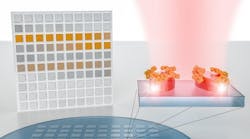Resonant-pixel nanosensor identifies molecules without using spectroscopy
Infrared spectroscopy is the benchmark method for detecting and analyzing organic compounds. But it requires complicated procedures and large, expensive instruments, making device miniaturization challenging and hindering its use for some industrial and medical applications and for data collection out in the field, such as for measuring pollutant concentrations. Furthermore, it is fundamentally limited by low sensitivities and therefore requires large sample amounts.
RELATED ARTICLE: Spectroscopy developments yield molecular pathology
However, scientists at EPFL's School of Engineering (Lausanne, Switzerland) and at Australian National University (ANU) have developed a compact and sensitive nanophotonic system that can identify a molecule's absorption characteristics without using conventional spectrometry. The scientists have already used their system to detect polymers, pesticides and organic compounds. What's more, it is compatible with CMOS technology.
Their system consists of an engineered surface covered with hundreds of tiny sensors called metapixels, which can generate a distinct bar code for every molecule that the surface comes into contact with. These bar codes can be massively analyzed and classified using advanced pattern recognition and sorting technology such as artificial neural networks. This research has been published in Science.
The pioneering system developed by the EPFL scientists is both highly sensitive and capable of being miniaturized; it uses nanostructures that can trap light on the nanoscale and thereby provide very high detection levels for samples on the surface. "The molecules we want to detect are nanometric in scale, so bridging this size gap is an essential step," says Hatice Altug, head of EPFL's BioNanoPhotonic Systems Laboratory and a coauthor of the study.
The system's nanostructures are grouped into what are called metapixels so that each one resonates at a different frequency. When a molecule comes into contact with the surface, the way the molecule absorbs light changes the behavior of all the metapixels it touches.
"Importantly, the metapixels are arranged in such a way that different vibrational frequencies are mapped to different areas on the surface," says Andreas Tittl, lead author of the study. This creates a pixelated map of light absorption that can be translated into a molecular bar code--all without using a spectrometer.
Artificial intelligence could be used in conjunction with this new technology to create and process a whole library of molecular bar codes for compounds ranging from protein and DNA to pesticides and polymers. That would give researchers a new tool for quickly and accurately spotting miniscule amounts of compounds present in complex samples.
SOURCE: EPFL; https://actu.epfl.ch/news/a-nanotech-sensor-turns-molecular-fingerprints-int/
About the Author

Gail Overton
Senior Editor (2004-2020)
Gail has more than 30 years of engineering, marketing, product management, and editorial experience in the photonics and optical communications industry. Before joining the staff at Laser Focus World in 2004, she held many product management and product marketing roles in the fiber-optics industry, most notably at Hughes (El Segundo, CA), GTE Labs (Waltham, MA), Corning (Corning, NY), Photon Kinetics (Beaverton, OR), and Newport Corporation (Irvine, CA). During her marketing career, Gail published articles in WDM Solutions and Sensors magazine and traveled internationally to conduct product and sales training. Gail received her BS degree in physics, with an emphasis in optics, from San Diego State University in San Diego, CA in May 1986.
